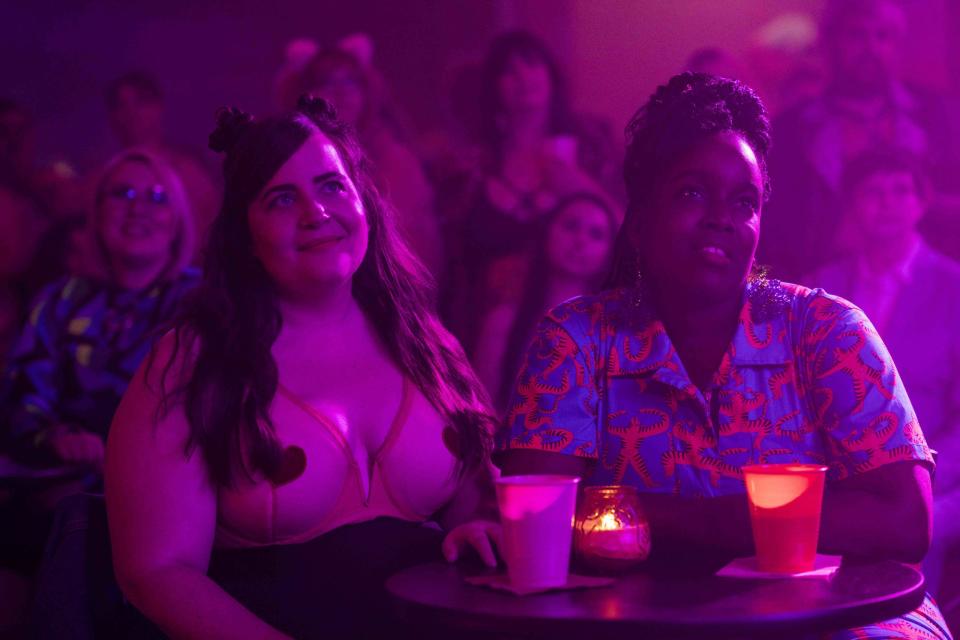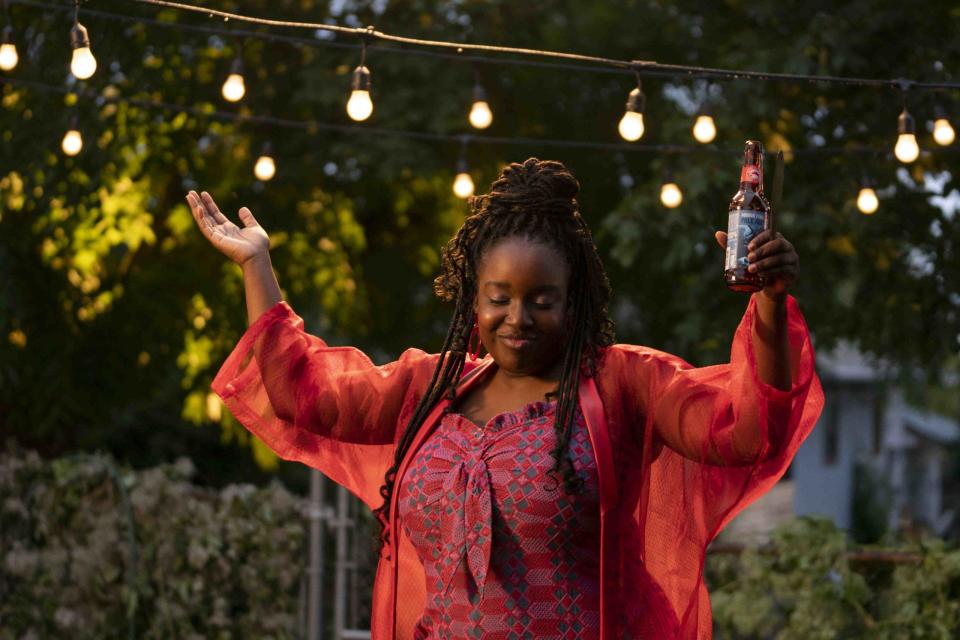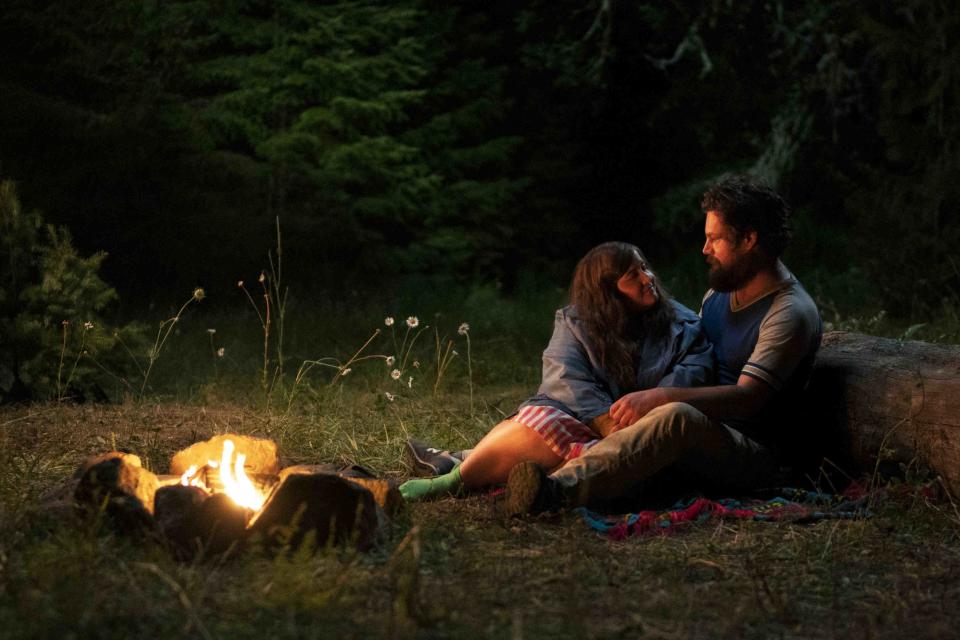On Shrill Season 2, Weight Is Barely a Topic—And That’s a Good Thing
When Shrill debuted on Hulu in March 2019, it was a revelation. For one of the first times in pop culture, we had a TV show that centered around a fat woman, Annie (Aidy Bryant), who wasn’t obsessed with changing her body. That doesn’t mean she was immune to fat-phobia, of course: In the first season Annie experienced body-shaming from her boss, her mother, and even a stranger on the street. The key was Annie herself never saw her body as an issue.
“I’m fat. I’m fucking fat. Hello? I’m fat!” she says at a pivotal moment in season one. After this mental switch, things changed: Annie became more outspoken, outgoing, and unafraid to take up space. She talked and walked and acted like any protagonist you’ve seen—she just happened to be fat. It was thrilling.
That same energy carries into season two, which drops on Hulu today (Friday, January 24). Perhaps the most revolutionary thing about it is how little being fat comes up.
“Annie is post-epiphany, as far as breaking this mental loop that she was in about hating herself,” Bryant tells Glamour. Adds Lolly Adefope, who plays Annie’s best friend, Fran, “In season one, we see the world trying to tell Annie to change. And in season two, we see her rejecting that and saying, “I am who I am, and I’m going to step into this life and embrace it. Sorry if you don’t accept that, but that’s who I’m going to be.’” Put another way, “Fatness is almost a coincidence by season two,” Adefope says.

Kevin
Coincidence is a good word to describe the dynamic between narrative and body type in Shrill’s second season. Annie’s weight is only really alluded to twice, and both times the storylines are nuanced. In one, Annie takes her boyfriend, Ryan (Luka Jones), to meet her parents for the first time; instead of the night centering on that, though, it becomes about her mom’s obsession with food. Annie tries to steer the conversation toward other topics, but her mom keeps on—which, in turn, makes Annie second-guess all the self-confidence she’s built.
“I think that is how a lot of fat people experience the world in a lot of ways,” Bryant says. “Where someone else’s experience of food or their own body or their own clothes comes to reflect on you in some way.”
She cites a wedding toast she once heard as an example: “In the toast they were saying, ‘Oh, this night we felt so thin and that was so good!’ I remember feeling like they were saying, in their minds, the best night of their life was the night they looked nothing like me.”
Bryant’s real-life anecdote, in a nutshell, reveals the main issue in Shrill’s next chapter: How do fat people who love their bodies go about navigating a world that constantly tells them they’re wrong? “I think that is part of what we were trying to circle around [in season two],” Bryant says. “Annie feels better about herself, but everyone around her is still stuck in that dark mentality that she was in at the beginning of season one.”
Shrill isn’t presenting an idealized world. It doesn’t gloss over the fact that living life as a fat person can be difficult, regardless of self-confidence. The season, in subtle ways, explores the push and pull of being body-positive in a culture that actively works against plus-size women (and men).

HR
Allyson Riggs/Hulu“It’s not [always] as easy as just being like, ‘You go, girl. Don’t let them get you down. Just go have fun,’” says executive producer Lindy West, who also wrote the source material for Shrill. “Because there are structural inequalities that make it really impossible for people to just ignore fat-phobia. We’re walking that line of giving Annie this agency to demand more from the people around her, and the institutions around her, while also always remembering that she still lives in a fat-phobic society that cares about her less than it does thin people.”
A simple example of this is when Annie attends a women’s empowerment conference and an employee doesn’t have her T-shirt size readily available. “The world around you constantly reminds you in various ways that you’re not appropriate, and you don’t fit, and you failed, and you’re gross,” West says. “But that’s not actually the defining characteristic of your life. You have family and friends and a job and relationships, and you care about politics, and you watch TV, and you like music, and you want to go dancing.”
That last sentence is crucial in seeing the differences between Shrill’s first and second seasons. In the former, we see Annie consumed with diet culture (at least at first). She talks to her mom about eating almonds. She stretches her clothes out. Her body doesn’t define her, obviously, but she spends a lot of time thinking about how to shrink herself. In the latter season, Annie lets go of that—and is happier for it. Finally she has the mental space to think about who she is outside of weight-loss obsession.
“If you don’t know yourself, how can you know anyone else?” Bryant says. “I think that’s part of what she’s getting at this season is just getting to know herself as this new person who doesn’t hate herself.”
This is something the SNL actor deeply identifies with. “I just feel like, in some ways, I spent probably 19 years or 20 years of my life trying to cover up who I might actually be for fear of being perceived as fat that I didn’t even think about, like, what did I think of politics?” she says. “What did I think of religion? My mind was consumed with making sure my shirt wasn’t too tight. What a waste. It’s almost like it’s interrupting you, those kinds of thoughts. It’s stopping you from just free-flowing in your mind.”

Camp
Those thoughts, largely, are a thing of the past for Annie. This season she explores her career, her relationship with Ryan, and her friendships without the added mental anguish about her body. And she realizes a few things, some of which may take her a few steps back in the self-image department. But that’s life, isn’t it? We move forward. We regress. We’re composed and disjointed all at once. It’s just that, until now, we really haven’t seen a plus-size female character get to be those things. It was mostly, as West aptly describes, just “fat woman, sad.” Shrill has changed that, especially in season two.
“Annie certainly is still a mess in season two in a lot of ways,” West says. “She’s still chaotic, but that’s okay. This process of figuring out how to unlearn what society has taught you about your own value can be messy, and it can take a long time and you can backslide. You can make progress, and then you can fall back. The important thing is that you keep trying. Be kind to yourself and take care of the people around you.”
Season two of Shrill is now streaming on Hulu.
Christopher Rosa is the staff entertainment writer at Glamour. Follow him on Twitter @chrisrosa92.
Originally Appeared on Glamour

